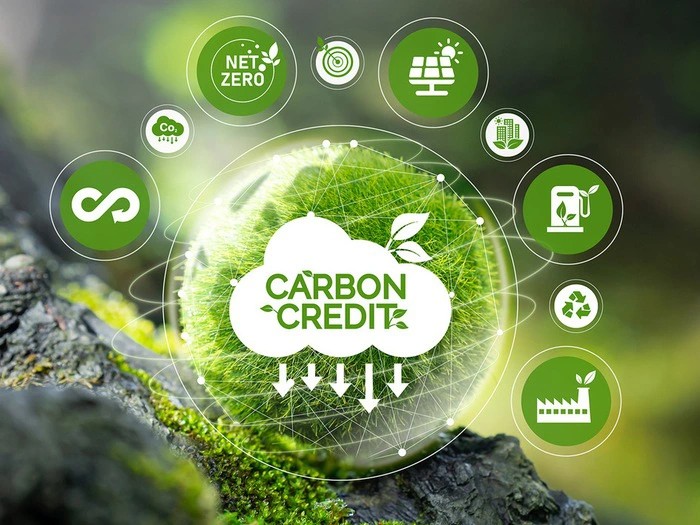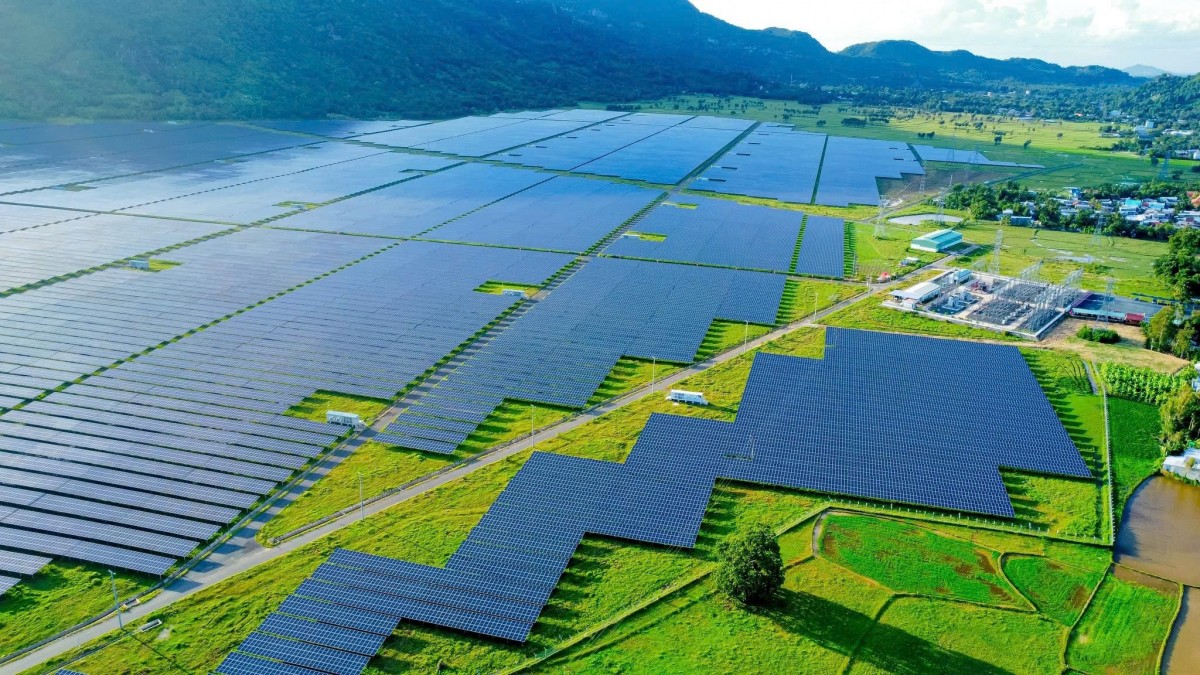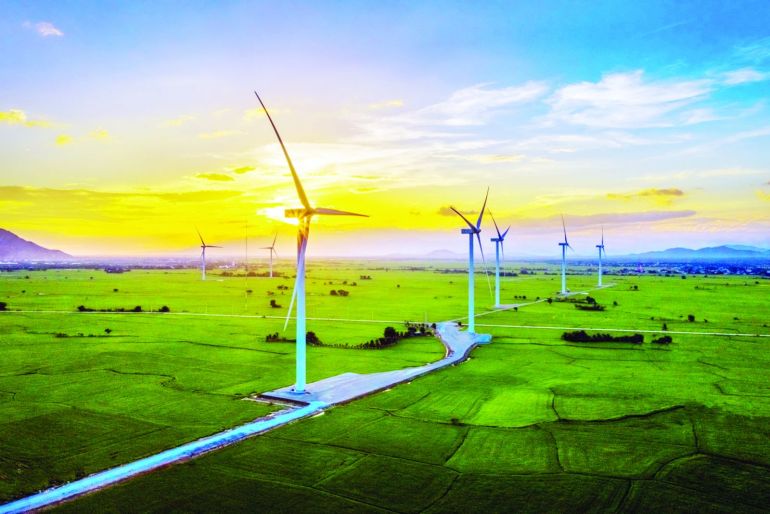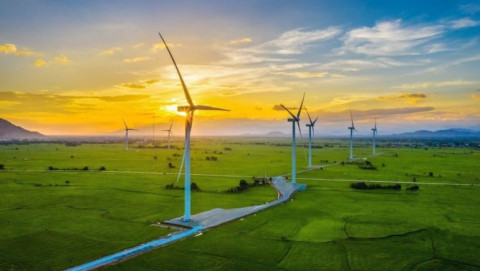Practical application of carbon credits to the economy. Part V: Carbon credits encourage businesses to invest in green initiatives
- 186
- Socially Responsible Enterprise
- 10:26 28/06/2024
DNHN - As climate change becomes increasingly severe, reducing carbon emissions is an urgent task for both governments and businesses. Encouraging businesses to engage in green activities and reduce their carbon emissions is beneficial.

Carbon credits create a competitive advantage for green investors
Carbon credits are units that represent the right to emit a certain amount of carbon dioxide. Each carbon credit is equivalent to one ton of carbon dioxide emissions reduced compared to a baseline level. Carbon credits can be generated through carbon reduction projects such as using renewable energy, sustainable forest management, or energy-saving technologies. Businesses can purchase carbon credits to offset their carbon emissions and achieve their environmental impact reduction goals.
One of the biggest benefits of carbon credits is the potential to generate passive income for businesses. By reducing carbon emissions and creating carbon credits, businesses can sell or trade these credits on the carbon market. Participating in the carbon market not only brings income but also motivates investment in greener technologies and processes. Businesses will seek to reduce their carbon emissions to create carbon credits and increase the value of their green stock.
Additionally, carbon credits create a competitive advantage for businesses that invest in green initiatives. In an increasingly environmentally-conscious market, businesses with carbon credits that demonstrate their commitment to reducing carbon emissions will attract interest and support from customers, investors, and the community. Engaging in green activities and owning carbon credits enhances company image, builds trust, and gains credibility with partners and consumers.
Beyond business benefits, carbon credits also have a positive impact on environmental protection and mitigating climate change. By emitting less carbon and purchasing carbon credits from emission reduction projects, businesses contribute to reducing carbon emissions and other pollutants. This helps protect not only the natural environment but also human health.
To encourage businesses to invest in green initiatives and utilize carbon credits, governments and related organizations can implement incentive measures. This could include providing tax incentives and financial support for businesses participating in carbon reduction projects and using renewable energy. Additionally, building and promoting the carbon market is a crucial factor to enhance the value of carbon credits and encourage business participation.
Carbon credit reserve fund for Vietnamese businesses
Currently, Ho Chi Minh City has been chosen as the first locality to implement a carbon credit exchange and offset mechanism. From 2025, Vietnam will pilot the carbon credit market. This means that around 1,912 large enterprises emitting up to 3,000 tons of carbon annually in Vietnam can purchase carbon credits if other measures do not meet emission reduction standards. This provides opportunities for sellers at better prices and buyers to access cheaper credits.
Assoc. Prof. Dr. Nguyen Dinh Tho, Director of the Institute of Strategy and Policy on Natural Resources and Environment (Ministry of Natural Resources and Environment), emphasized: "Implementing a voluntary carbon market offers more opportunities for people, ethnic groups, and communities involved in carbon absorption such as forests or rice emissions."

Mr. Tho stated that in 2024, Ho Chi Minh City set two main goals: promoting green growth and implementing digital transformation. These are crucial steps towards the city's development, aiming for a sustainable economy, reducing carbon emissions, and achieving a 10% emission reduction target by 2030.
Currently, the city is attracting investment in 28 projects in various fields such as transportation, high technology, renewable energy, electronics, semiconductors, and data centers. Through carbon credit trading, Ho Chi Minh City not only attracts investors but also contributes to promoting a green economy not just within the city but nationwide.
Regarding this issue, Mr. Nguyen Toan Thang, Director of the Department of Natural Resources and Environment of Ho Chi Minh City, shared information at the seminar "Carbon Credit Market - Driving Force for Building a Green Vietnam". Mr. Thang emphasized that Ho Chi Minh City has been selected as the first locality to pilot the carbon credit exchange and offset mechanism, according to Resolution 98. Currently, the city is focusing on two main projects to conduct carbon credit transactions, including replacing street lights with LED lights and installing rooftop solar systems at office buildings.
Meanwhile, Mr. Nguyen Van Minh, Head of the Economic and Climate Change Information at the Department of Climate Change (Ministry of Natural Resources and Environment), shared that the price of carbon credits fluctuates significantly in different countries, ranging from $1 to $140 per ton of carbon. Mr. Minh explained that in some cases, the EU uses the unit of tons of CO2 quotas instead of carbon credits. "Carbon credits are mainly traded in the voluntary market, and recent prices range from $1 to $2 depending on the type of credit," Mr. Minh added.
Dr. Pham Van Dai, Senior Lecturer at the Fulbright School of Public Policy and Management, stated that determining the selling price of carbon credits is quite complex because it is a market. The selling price of carbon credits also depends on their quality, with some types selling for high prices of $200-300 per credit after calculating project implementation costs.
According to Dr. Dai, given the current context, Vietnam needs to plan carbon credits as a resource that needs to be protected. He also proposed the establishment of a Carbon Credit Reserve Fund for Vietnamese businesses to help alleviate the cost burden when participating in global carbon credit markets.
Nghe Nhan
Related news
- Practical application of carbon credits in the economy. Part III: The issuance and trading process of carbon credits
- Practical application of carbon credits to the economy. Part II: Building infrastructure in the fight against climate change
- Practical application of carbon credits to the economy. Part I: The necessity of reducing carbon emissions
#environmental protection

Reducing greenhouse gas emissions and carbon market development to fulfill COP 26 commitments
Vietnam aims to reduce greenhouse gas (GHG) emissions and develop a carbon market, aligning with its COP 26 commitments. This requires close coordination and comprehensive solutions from all sectors and communities.

What can be learned from VinFast's success after becoming the best-selling car brand in Vietnam?
VinFast's market-leading sales in Vietnam in September marked a major turning point, as a domestic electric vehicle brand outpaced international competitors.

Nurturing life for the future with clean energy
Vietnam has just endured Typhoon No. 3, leaving behind a trail of destruction and loss that makes us all feel small against Mother Nature. It is time for a change, time to nurture and protect our living environment.

Practical applications of carbon credits in the economy. Part XXI:Carboncor Asphalt - An effective solution for Vietnam to achieve net zero emissions
Vietnam is actively implementing green construction solutions to achieve the goal of net zero emissions by 2050. These solutions reduce greenhouse gas emissions and support sustainable development in the construction industry.

Practical applications of carbon credits in the economy. Part XI: Bridging policy and strategy for the carbon credit market
To develop the carbon credit market, the Government and businesses must improve cooperation and communication. The Government needs to provide clear policies, while businesses must adopt emission reduction strategies and leverage carbon credits.

Yen Bai: Implementing the plan to manage and eliminate ozone-depleting substances and greenhouse gases
The People's Committee of Yen Bai province has just issued document No. 3005/UBND-TNMT on the implementation of the National Plan for the management and elimination of ozone-depleting substances and controlled greenhouse gases.
Đọc thêm Socially Responsible Enterprise
When artists do business – livelihood is no poetry!
A series of indictments, arrests, and bankruptcies among artists has sounded a serious alarm.
Hanoi’s economy grows 7.92% in first nine months of 2025, FDI surges nearly threefold
Hanoi maintained robust growth momentum in the first nine months of 2025 with GRDP up 7.92% year-on-year, driven by strong services and construction sectors.
Vietnam’s strong gdp growth fails to ease labor market distress
As the year draws to a close, the pressing challenge for businesses and policymakers is how to rebuild worker morale, retain top talent, and stabilize employment amid lingering uncertainty.
Vietnam ramps up efforts to lift EU “Yellow Card” on Illegal fishing
Prime Minister Pham Minh Chinh has called for intensified and coordinated efforts to have the European Commission’s “yellow card” on Vietnam’s fisheries removed within this year.
Quang Tri calls for investment in wind power plant project worth over VND 1,100 billion
The People’s Committee of Quang Tri Province has officially announced the Hưng Bắc Wind Power Plant Project as part of its investment invitation portfolio.
Hanoi receives two million visitors during the four-day National Day holidays
From August 30 to September 2, Hanoi received around 2.08 million visitors during the four-day National Day holidays , three times higher than the figure in the same period last year, the municipal Department of Tourism reported.
Ca Mau gradually makes its mark on the national tourism map
By 2025, Ca Mau aims to attract 8.4 million visitors and achieve a total revenue exceeding 8,585 billion VND, contributing to the province's double-digit growth target.
UNDP Resident Representative hails Vietnam as an emerging economic powerhouse
Millions of people have been lifted out of poverty, hunger has been eliminated, and the economy has maintained consistent growth rates of over 6 per cent, UNDP Resident Representative in Vietnam Ramla Khalidi remarks.
Alpha Books Chairman Nguyen Canh Binh: The survival weapons of Vietnamese entrepreneurs in the age of AI.
Alpha Books Chairman Nguyen Canh Binh shares three essential lessons to ensure the survival and growth of Vietnamese entrepreneurs in the digital age: creativity, connection, and collective intelligence.
Mr. Le Viet Thang, CEO of 1Office: "Don’t use old solutions for new ai challenges"
As artificial intelligence (AI) reshapes the global technology landscape, Vietnam is taking decisive steps to establish a National AI Research and Development Center, alongside the National Data Center.











